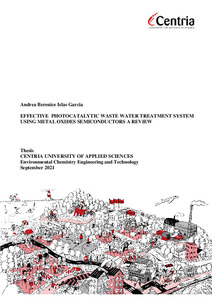Effective photocatalytic waste water treatment system using metal oxides semiconductors : A review
Islas Garcia, Andrea Berenice (2021)
Islas Garcia, Andrea Berenice
2021
All rights reserved. This publication is copyrighted. You may download, display and print it for Your own personal use. Commercial use is prohibited.
Julkaisun pysyvä osoite on
https://urn.fi/URN:NBN:fi:amk-2021101318612
https://urn.fi/URN:NBN:fi:amk-2021101318612
Tiivistelmä
Life is not possible without water. Worldwide, there is an urgent need for clean and safe water. This review presents the principles and mechanisms underlying heterogeneous photocatalysis, and its applications in wastewater treatment.
The purpose of photocatalysis is to break down complex molecules such as viruses, bacteria, organic compounds into simple and non-hazardous substances which are then disposed by wastewater treatment. This means that no residues or sludge are left behind. The hydroxyl radical and superoxide radicals are formed by the oxidation of solar photons using semiconductor photocatalysts. TiO2 is the principal studied photocatalyst in this thesis, its modification by doping, parameters for efficiency, and its removal at the end of the process are also reviewed. Photocatalysis is also known to be a green technology since solar energy can be used as the activation agent of the photocatalyst. Although other methods of light exposure are also mentioned in this thesis a special emphasis on solar photoreactors is made in sub-chapter 7.2 , since solar energy is the preferred source for decontaminating for its environmental and low economic impact.
The purpose of photocatalysis is to break down complex molecules such as viruses, bacteria, organic compounds into simple and non-hazardous substances which are then disposed by wastewater treatment. This means that no residues or sludge are left behind. The hydroxyl radical and superoxide radicals are formed by the oxidation of solar photons using semiconductor photocatalysts. TiO2 is the principal studied photocatalyst in this thesis, its modification by doping, parameters for efficiency, and its removal at the end of the process are also reviewed. Photocatalysis is also known to be a green technology since solar energy can be used as the activation agent of the photocatalyst. Although other methods of light exposure are also mentioned in this thesis a special emphasis on solar photoreactors is made in sub-chapter 7.2 , since solar energy is the preferred source for decontaminating for its environmental and low economic impact.
